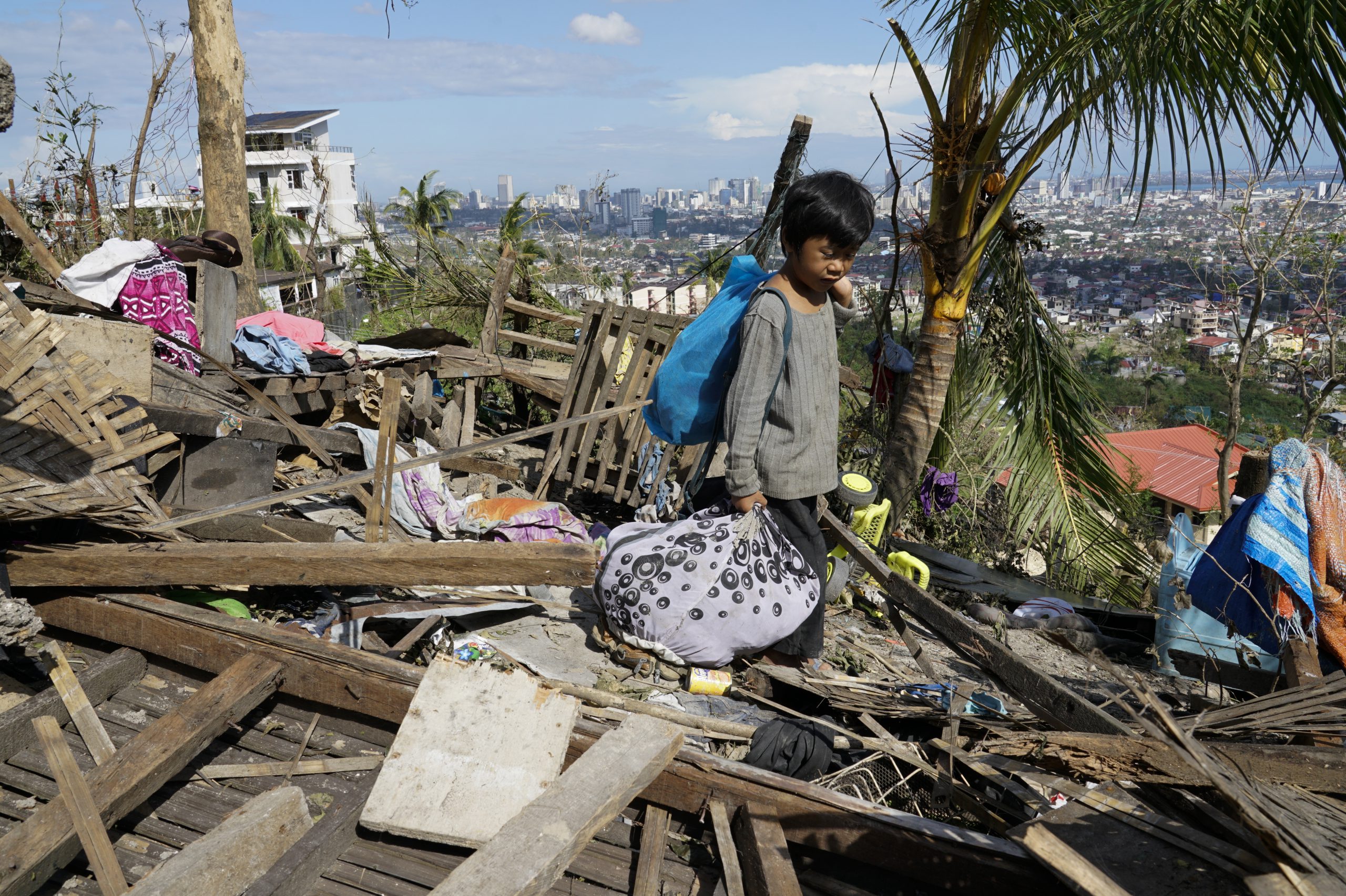Death toll from Typhoon Rai surges to 375 in Philippines
ارتفاع حصيلة ضحايا إعصار “راي” بالفلبين إلى ٣٧٥ قتيلاً
AFP
The death toll from the strongest typhoon to hit the Philippines this year has reached 375, the national police said Monday, making it one of the deadliest storms to hit the country in recent years.
Another 500 were injured and 56 were missing after Typhoon Rai ravaged the southern and central regions of the archipelago, the police tally showed.
More than 300,000 people fled their homes and beachfront resorts as Rai slammed into the country on Thursday as a super typhoon.
The Philippine Red Cross has reported “complete carnage” in coastal areas.
“Homes, hospitals, school and community buildings have been ripped to shreds,” Red Cross Chairman Richard Gordon said earlier.
The storm tore off roofs, uprooted trees, toppled concrete power poles, smashed wooden houses to pieces and flooded villages – sparking comparisons with Super Typhoon Haiyan in 2013.
Haiyan, called Yolanda in the Philippines, was the deadliest cyclone on record in the country, leaving more than 7,300 people dead or missing.
One of the hardest-hit islands this time was Bohol – known for its beaches, rolling “Chocolate Hills”, and tiny tarsier primates – where at least 74 people have died, provincial Governor Arthur Yap said on his official Facebook page.
There has also been widespread destruction on Siargao, Dinagat and Mindanao islands, which bore the brunt of the storm when it slammed into the country packing wind speeds of 195 kilometres (120 miles) per hour.
At least 10 people died on the Dinagat Islands, provincial information officer Jeffrey Crisostomo told AFP on Sunday.
S.O.S was painted on a road in the popular tourist town of General Luna on Siargao island, where surfers and holidaymakers had flocked ahead of Christmas, as people struggle to find water and food.
Swathes of the affected areas have no communications, hampering efforts of disaster agencies to assess the full extent of the storm’s damage.
Electricity also has been knocked out, affecting water-refilling stations and ATMs.
Thousands of military, police, coast guard and fire personnel have been deployed to assist in search and rescue efforts.
Coast guard and naval vessels carrying food, water and medical supplies have been dispatched, while heavy machinery – like backhoes and front-end loaders – have been sent to help clear roads blocked by fallen power poles and trees.
Rai hit the Philippines late in the typhoon season – most cyclones typically develop between July and October.
Scientists have long warned that typhoons are becoming more powerful and strengthening more rapidly as the world becomes warmer because of human-driven climate change.
The Philippines – ranked among the globe’s most vulnerable nations to the impacts of climate change – is hit by an average of 20 storms and typhoons every year, which typically wipe out harvests, homes and infrastructure in already impoverished areas.
ا ف ب
أفادت آخر حصيلة رسمية عن وفاة أكثر إلى 375 قتيلا وفق الشرطة الوطنية في الفلبين بالإضافة إلى مئات الجرحى وعشرات المفقودين جراء مرور الإعصار “راي”. وكشفت صور جوية نشرها الجيش عن دمار كبير في المناطق المتضررة. واضطر أكثر من 300 ألف شخص إلى ترك منازلهم.
لقي ما لا يقل عن 375 شخصا حتفهم في الفلبين جراء الإعصار “راي”، الأشد الذي يضرب البلد هذه السنة، وفق حصيلة رسمية جديدة صدرت الأحد، فيما تجهد فرق الإغاثة لتوزيع المياه والمواد الغذائية في الجزر المنكوبة.
وفي وقت سابق أشارت حصيلة أولية الأحد إلى مقتل 109 أشخاص جراء “راي”، وهو أحد أعنف الأعاصير التي تضرب البلاد في السنوات الأخيرة. وأظهرت أرقام الشرطة أن 500 شخص آخرين أصيبوا بجروح فيما فُقد أثر 56 شخصا جراء الإعصار راي الذي ضرب الأرخبيل.
ضرب الإعصار مصحوبا برياح بلغت سرعتها 195 كلم/ساعة وسط الفلبين وجنوبها الخميس والجمعة، وأدى إلى اقتلاع أسقف المنازل ودمر أبراج اتصالات وأسقط أعمدة كهرباء واقتلع أشجارا قبل أن يتّجه السبت نحو بحر الصين الجنوبي.
وكشفت صور جوية نشرها الجيش عن دمار كبير في المناطق المتضررة. واضطر أكثر من 300 ألف شخص إلى ترك منازلهم.
وأعلن حاكم جزيرة بوهول السياحية (وسط) آرثر ياب، في وقت سابق، أن 73 شخصا على الأقل لاقوا حتفهم في مقاطعته، وفقا لبيانات رؤساء البلديات.
وفي جزيرة ديناجات، قال مسؤول الإعلام في الإقليم جيفري كريسوستومو برس إن عشرة آخرين لقوا حتفهم.
ويُرجح ارتفاع عدد الضحايا مع وصول فرق الإنقاذ إلى المناطق التي دمرها الإعصار.
وانتشر آلاف من عناصر الجيش والشرطة وخفر السواحل ورجال الإطفاء للمساعدة في عمليات البحث والإنقاذ في المناطق الأكثر تضررا. ونقلت سفن الجيش وخفر السواحل الماء والغذاء والدواء. كما وصلت آليات ثقيلة لتنظيف الطرق التي قطِعت عند سقوط أشجار وأعمدة كهرباء.
وأشار ألبرتو بوكانيغرا مسؤول الاتحاد الدولي لجمعيات الصليب الأحمر والهلال الأحمر في الفلبين إلى أن “الطريق سيكون طويلا وصعبا أمام السكان لإعادة البناء وتولي زمام أمورهم”. فيما دعت المنظمة إلى جمع 20 مليون فرنك سويسري (19,3 مليون يورو) لتمويل جهود الإغاثة وإعادة الإعمار.
وأعرب البابا فرنسيس عن “تعاطفه مع شعب الفلبين”، البلد الذي تقطنه غالبية كاثوليكية. وقال بعد صلاة التبشير الأحد “ليحمل القديس نينو العزاء والأمل للعائلات التي تواجه صعوبات وليلهمنا جميعا تقديم مساعدة ملموسة”.
وقال حاكم جزيرة بوهول السياحية إن التحليق فوق المناطق المنكوبة أظهر أن “السكان تضرروا بشدة جراء تدمير منازلهم وخسارة مزروعاتهم”.
ويحذر علماء منذ فترة من أن الأعاصير تزداد عنفا مع تزايد الاحترار المناخي الناجم عن نشاط الإنسان.
يضرب الفيليبين، إحدى أضعف الدول في مواجهة التغير المناخي، سنويا حوالى عشرين إعصارا تشيع الدمار في المساكن وتقضي على محاصيل وبنى تحتية في مناطق تعاني أصلا من الفقر.




